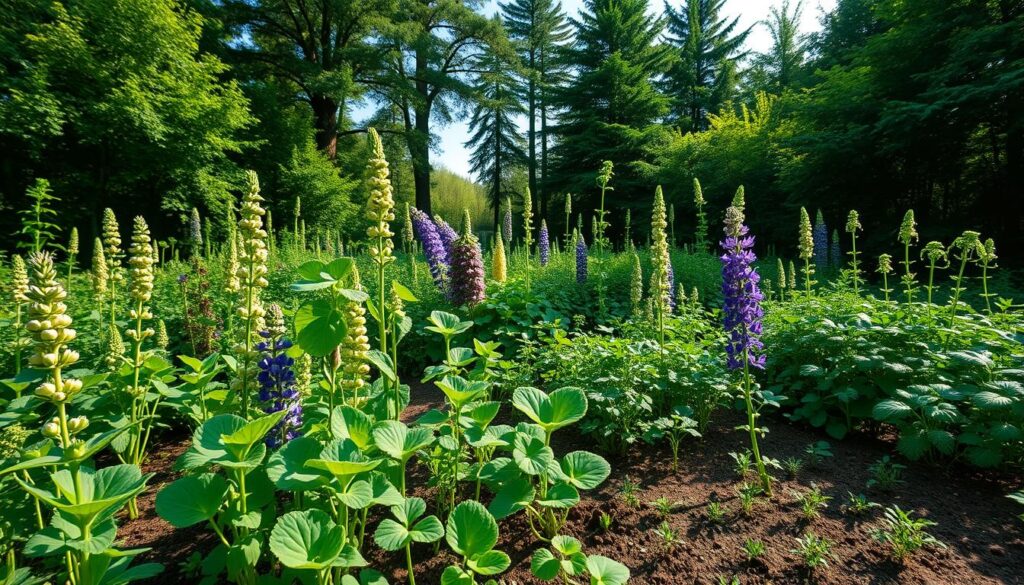As I get ready for my spring garden, I’m eager to share the perks of companion planting. This method boosts plant health and increases yields without harsh chemicals. By picking the right pairs, your garden can flourish, and I’m here to guide you with some great tips.
Companion planting is all about helping plants grow better together. For instance, marigolds with tomatoes can keep nematodes away and attract good bugs. With 15 plants suggested for artichokes and 15 for chard, the choices are vast. I’m excited to dive into these options with you.
Adding companion planting to your garden can cut down on chemical use. It makes veggies healthier and boosts your harvest. Whether you’re new to gardening or have experience, this method is easy and effective. I’m looking forward to sharing more tips and tricks with you in this article.
Understanding the Magic of Companion Planting

Companion planting is all about how plants help each other grow. By knowing how different plants work together, you can make your garden better. It becomes more resistant to pests and diseases. Plus, it attracts good insects that help pollinate and control pests.
Some plants, like marigolds and nasturtiums, keep pests away and draw in beneficial insects. Others, like beans and corn, help each other out. For instance, the “Three Sisters” method from Native Americans plants corn, beans, and squash together. The corn supports the beans, the beans fix the soil, and the squash keeps weeds and moisture in.
Using companion planting in your garden can make it stronger and more productive. You might see your yields go up by 20%. It can also cut down pest problems by 50% or more, making your crops healthier. Plus, legumes like beans and peas can add up to 30% more nitrogen to the soil.
Tomatoes and Basil: The Classic Partnership
Tomatoes and basil are a match made in heaven when it comes to gardening. They’re a classic duo that many gardeners love. Basil helps keep pests away from tomatoes, like aphids and whiteflies. This makes the garden a healthier place for both plants.
Planting tomatoes and basil together can make your garden better in many ways. Tomatoes grow bigger and taste sweeter when basil is around. Basil attracts good bugs and keeps away bad ones. This helps tomatoes grow strong and healthy.
For more tips on growing tomatoes and basil together, check out this resource. It’s full of advice on creating a balanced garden.
- Improved pest control: Basil repels pests that can harm tomatoes, reducing the need for pesticides.
- Enhanced flavor: Tomatoes planted with basil have a more robust flavor profile.
- Increased yields: Companion planting with basil can increase tomato yields by up to 50%.
Adding tomatoes and basil to your garden can make it more balanced and healthy. It’s a win-win for both plants.
Carrots and Onions: Underground Allies
Exploring companion planting, I’m thrilled to talk about carrots and onions. These two veggies work well together, helping each other grow and fight pests. Onions keep carrot flies away, which is better than using harmful chemicals.
Planting carrots and onions together saves space. Carrots grow deep, while onions spread out. This way, they don’t fight over water or nutrients. Onions even make carrots taste better because of their sulfur.
When planting, think about when to plant carrots and onions. You can plant them in early spring or late summer. Onions need about 8 inches of space, but you can plant them closer in raised beds. This method helps your garden stay healthy and pest-free. Learn more about companion planting at farmstore.com.
Planting carrots and onions together also improves your soil and increases your harvest. Carrots loosen the soil, and onions add nutrients. This way, you can grow a greener, healthier garden without using harmful chemicals.
Marigolds: Your Garden’s Best Friend
Marigolds are a fantastic addition to any garden. They keep pests away and attract good bugs, which helps your garden stay healthy. By growing marigolds with your veggies, you make your garden better at fighting off pests and diseases.
Some of the benefits of planting marigolds in your garden include:
- Repelling harmful insects, such as aphids and nematodes
- Attracting beneficial insects, like bees and butterflies
- Improving soil health and reducing weed growth
- Enhancing the growth and flavor of nearby vegetables
Marigolds are simple to grow and fit well in many spots. They don’t need much care and don’t take up a lot of nutrients, which helps other plants. Their bright colors also make your garden look great.
| Plant | Benefits of Planting with Marigolds |
|---|---|
| Tomatoes | Increased pollination and reduced pest damage |
| Cucumbers | Protection from pests and increased yield |
| Carrots | Reduced competition for nutrients and improved growth |
In summary, marigolds are a smart choice for gardeners. They help keep pests away and attract helpful insects. This makes your garden a better place to grow plants.
The Three Sisters: Corn, Beans, and Squash
I’ve always been fascinated by the Three Sisters method from Native American gardening. It involves planting corn, beans, and squash together. This ancient technique creates a balanced and diverse garden ecosystem.
By using this method, your garden becomes more resistant to pests and diseases. It also needs less maintenance and care.
Native American Gardening Wisdom
The Three Sisters method is all about companion planting. Each plant helps the others. The corn supports the beans, while the beans add nitrogen to the soil.
The squash leaves cover the soil, reducing weeds and evaporation. Native American gardeners have used this method for over 300 years. It’s popular worldwide today.
Modern Applications of This Ancient Technique
To try the Three Sisters method, plant corn, beans, and squash together. Start with four to six corn seeds in a mound. Then, plant four bean seeds around the corn when it’s six inches tall.
Plant six squash seeds around the mound’s edge a week after planting the beans. This method boosts biodiversity, attracting pollinators and enriching the soil. With some planning and care, you’ll have a thriving Three Sisters garden.
Some benefits of the Three Sisters method include:
* Increased crop yields
* Improved soil fertility
* Reduced pest and disease problems
* Increased biodiversity
* A more balanced and diverse garden ecosystem
Companion Planting Combos to Boost Your Spring Garden Success
Exploring gardening, I found that companion planting is key for a successful spring garden. It helps you pick the best plant friends. This way, your garden fights off pests and diseases better.
For example, tomatoes and basil together make tomatoes taste better and grow more. Carrots and onions help keep pests away. Marigolds can even cut down nematode and insect harm by up to 50%. Learn more about these combos at a companion planting guide.
Other excellent pairings for spring gardens include:
- Legumes with nitrogen-demanding plants to enhance soil fertility
- Marigolds with vegetables to repel nematodes and harmful insects
- Onions and carrots to improve pest resistance
Adding these combos to your garden makes it healthier and easier to care for. This approach boosts soil health, cuts down on pests, and increases your harvest. It’s a win-win for your spring garden.
Lettuce and Tall Plants: Shade Gardening Strategy
Lettuce and tall plants make a great team in shade gardening. Lettuce likes some shade, which is perfect in warm weather. Tall plants like peppers and sunflowers offer the shade lettuce needs. This combo helps your garden stay healthy and fight off pests and diseases.
For more info on planting together, check out companion planting charts. They show the best pairings for your garden.
Best Shade-Providing Plants
Here are some top plants for shade:
- Peppers
- Sunflowers
- Corn
Temperature Management Tips
Managing temperature is key in shade gardening. Lettuce likes it cool, while sunflowers prefer it warm. Planting them together creates a good environment for both. This helps keep your garden healthy and pest-free.
Pest-Deterrent Duos for Natural Garden Protection
As a gardener, I’ve found that some plants naturally keep pests away. This makes them great for creating pairs that protect your garden. These pairs help your garden stay healthy and balanced, fighting off pests and diseases.
For instance, garlic and hot peppers are a fantastic duo. Garlic keeps aphids, spider mites, and other pests at bay. Hot peppers, on the other hand, chase away nematodes and whiteflies. Other effective pairs include basil and mint, and marigolds with vegetables.
Here are some examples of pest-deterrent duos you can use in your garden:
- Garlic and hot peppers: Repel aphids, spider mites, and other pests
- Basil and mint: Deter pests like aphids and spider mites
- Marigolds and vegetables: Repel nematodes and whiteflies
Using these pest-deterrent duos can make your garden thrive with less work. Just pick the right pairs for your garden and try different ones to see what works best.
Herbs That Enhance Vegetable Growth
As a gardener, I’ve found that herbs can really help my vegetables grow. Planting certain herbs with my veggies makes my garden healthier. Herbs like basil, mint, and cilantro are great for this. They also help create scents that are good for my garden.

Aromatic Combinations for Vegetable Growth
Herbs like basil and mint keep pests away from my veggies. By mixing these herbs with my vegetables, I make a strong scent. This scent helps my veggies grow better and keeps pests away. For instance, basil and tomatoes together make tomatoes taste better and grow more.
Spacing and Maintenance Tips
To make my herbs and veggies grow well, I follow some important tips. I plant them at the right distance, water them often, and give them enough sunlight and nutrients. This way, my garden is full of tasty and healthy herbs and veggies.
Other herbs that help veggies grow include:
- Cilantro, which makes carrots and other root veggies grow better and taste sweeter
- Dill, which attracts good bugs and keeps pests away
- Chives, which keep aphids and other pests off
Flowers and Vegetables: Beautiful and Beneficial Pairs
Combining flowers and vegetables in your garden can be a game-changer. Planting certain flowers with your vegetables can make your garden healthier. This is called companion planting and it boosts garden health and beauty.
Some excellent flower and vegetable pairs include marigolds with tomatoes, nasturtiums with cucumbers, and sunflowers with lettuce. These pairs help keep pests away and attract good insects. For instance, marigolds fight nematodes, which helps the soil and protects other plants.
Here are more beneficial pairs to think about:
- Nasturtiums and cucumbers: Nasturtiums keep aphids and whiteflies away, helping cucumbers.
- Lavender and carrots: Lavender fights mosquitoes and ants, making the garden healthier.
- Bee balm and squash: Bee balm attracts pollinators, which is key for growing fruits and veggies.
Adding flowers to your vegetable garden makes it more diverse and strong. This method cuts down on chemical pesticides and makes your garden look better. So, why not try companion planting and see the difference for yourself?
Root Vegetable Combinations for Maximum Space Efficiency
Root vegetables are great for a space-efficient garden. Planting them together creates a balanced garden. This balance helps fight pests and diseases. Good pairs include carrots and beets, radishes and turnips, and parsnips and rutabagas.
These pairs use both vertical and horizontal space well. Plant taller veggies like parsnips and rutabagas on the north side. Shorter ones like carrots and beets go on the south side. This way, your garden stays open and productive.
Benefits of Succession Planting
Succession planting is key for a full garden. Plant small batches of veggies every few weeks. This keeps your harvest going all season. It also cuts down on waste and saves you time.
Vertical and Horizontal Space Planning
Plan your garden space carefully for the best results. Use raised beds or containers for vertical space. For horizontal space, try trellises or supports for climbing plants like peas and beans.
- Carrots and beets: These root vegetables can be planted together to create a space-efficient garden.
- Radishes and turnips: These combinations can help to repel pests and improve soil health.
- Parsnips and rutabagas: These taller root vegetables can be planted towards the north to make the most of your garden space.
Nitrogen-Fixing Plants and Heavy Feeders
When planning my garden, I think about the benefits of nitrogen-fixing plants. These plants, like beans and peas, turn atmospheric nitrogen into a form plants can use. They are a big help in any garden.
Heavy feeders, such as corn and squash, need lots of nutrients to grow. By planting nitrogen-fixing plants with them, I make a balanced garden. This method cuts down on fertilizer use and helps plants grow well.
Here are some good pairs:
- Beans and corn: Beans give nitrogen to corn, which needs a lot.
- Peas and cucumbers: Peas add nitrogen, helping cucumbers grow.
- Clover and squash: Clover fixes nitrogen, helping squash grow.

By using nitrogen-fixing plants and heavy feeders, my garden becomes diverse and healthy. It needs less care. This is good for the plants and the environment, as it cuts down on synthetic fertilizers and supports green gardening.
Beneficial Insect Attractors and Their Companions
Exploring companion planting, I’m thrilled to talk about attracting beneficial insects. These creatures help keep our gardens healthy and balanced. They are key in pollination and controlling pests, making them essential for our gardens.
Some plants are better at attracting these insects than others. Butterfly bush, bee balm, and lavender are great choices. Marigolds, nasturtiums, and sunflowers also help create a supportive environment. By adding these plants, we can have a garden that’s easy to care for. For more ideas, check out spring garden ideas.
Butterfly-Friendly Combinations
Butterfly-friendly plants like butterfly bush and lantana draw these lovely creatures. Pairing them with marigolds and sunflowers makes a welcoming space for butterflies. Other beneficial insects include:
- Nasturtiums, which attract beneficial insects that prey on aphids and whiteflies
- Calendula, which traps aphids on its sticky stems
- Chamomile, which attracts beneficial insects for brassicas like cabbage
Bee-Attracting Pairs
Bee-attracting plants like bee balm and lavender are vital for pollinators. Pairing them with borage and sweet alyssum supports bees. By adding these plants to our gardens, we create a strong ecosystem against pests and diseases.
Small Space Companion Planting Solutions
As a gardener with limited space, I’ve found that small gardens can be just as fruitful as big ones. This is thanks to companion planting. By picking the right plants together, I can grow a lot in a little space and with less work.
My top picks for small gardens include marigolds with tomatoes, basil with lettuce, and radishes with cucumbers. These pairs not only save room but also keep pests away. This makes my garden healthy and balanced.
For instance, marigolds keep nematodes from harming tomatoes. Basil makes lettuce taste better. Radishes keep cucumber beetles away, which helps prevent diseases. Using these pairings, my garden is strong against pests and diseases.
There are many ways to use companion planting in small gardens. I can use vertical gardening to make the most of space. Or, I can group plants that need the same water and sunlight. These methods help my garden thrive, even in tiny spaces.
Small space gardening also has other perks. It can increase crop yields, improve soil, and lower pest numbers. By picking the right plants, my garden is not just productive but also lovely and varied. Whether I’m growing veggies, herbs, or flowers, companion planting makes my garden a joy to tend.
Common Companion Planting Mistakes to Avoid
As a gardener, I’ve learned that avoiding common companion planting mistakes is key. It helps create a healthy and balanced garden. By focusing on the right plant combinations, spacing, and timing, I can avoid mistakes. These mistakes can lead to lower yields and poor plant growth.
Some common mistakes include planting members of the same family together, like tomatoes and peppers. Also, not giving each plant enough space is a big mistake. Overcrowding can cut yields by up to 30% because plants compete for space and resources.

To avoid these mistakes, it’s important to research the best plant combinations for your garden. Also, follow proper spacing and timing guidelines. Here are some tips to keep in mind:
- Plant annuals and perennials in separate beds to avoid competition
- Use ground cover plants to reduce weed growth and improve soil health
- Practice crop rotation every 3-4 years to maintain soil health and reduce pest issues
By following these tips and being aware of common mistakes, I can create a thriving garden. This garden needs less maintenance and care. Remember, companion planting is about creating a balanced ecosystem. So, take the time to research and plan your garden carefully. This way, you can avoid mistakes and enjoy a bountiful harvest.
Conclusion: Creating Your Perfect Spring Garden Partnership
Thinking about companion planting makes me realize the importance of the right plant pairs. By choosing the right plants together, we can make a garden that looks after itself. This way, we get more food with less work.
There are many great plant pairs, like tomatoes and basil, or the “Three Sisters” of corn, beans, and squash. These pairs help each other in many ways. They can keep pests away, save space, and even make the soil better.
When planning your garden, try out different plant pairs. Watch how they grow and work together. Companion planting is all about nature’s harmony. With a bit of creativity, your garden can become a place of growth and joy for everyone.


